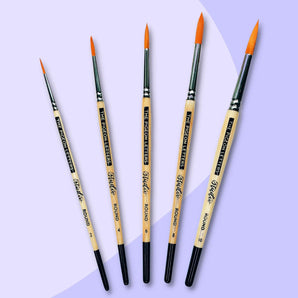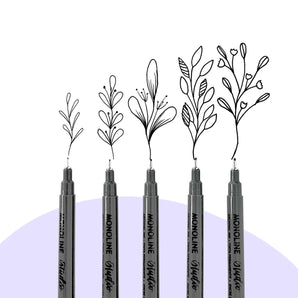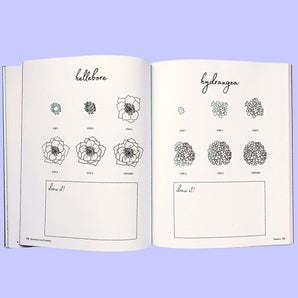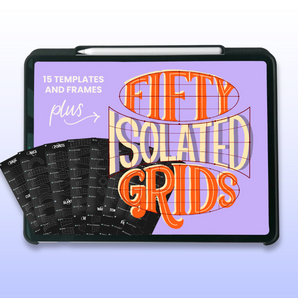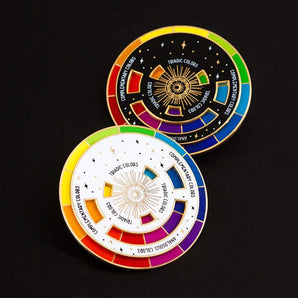Ribbon lettering is an impressive technique that makes your lettering stand out and look realistic. The trick for creating this effect is knowing where to add outlines and shading. It only requires a brush pen and a monoline pen, and it’s easier to create than you might think - just follow these 5 steps!

Supplies:
- Brush Pen
-
Monoline Pen (black or a few shades darker than brush pen)
Step 1: Write the word using a brush pen
Normally in brush lettering, you aim to make the upstrokes much thinner than the downstrokes (and that’s not easy!). With the ribbon technique, you can apply some pressure on the upstrokes. This will make sure there isn’t too much contrast in the stroke weight. After all, the effect should resemble a continuous ribbon.
You can also think about making the letterforms slightly more “boxy” than normal, especially where there is a transition between thick and thin. For example, bottom curve of the “o” and the top curve of the “n” are a bit flattened rather than rounded.

Step 2: Use monoline pen to outline the downstrokes
Locate the downstrokes in your lettering and use the monoline pen to carefully trace the outline. The shape formed will look like a curved rectangle. Make sure the outline extends all the way to the top and bottom of the stroke. The vertical lines will “cut through” the brush pen stroke at the point where they connect to the top and bottom edges, and the slight curve at the end of each line should follow through with the shape and curvature of the letter.
Outlining the downstrokes will cause them to appear as the part of ribbon “in front” of the folds.

Step 3: Outline the remaining strokes
Using the same monoline pen, outline the thin strokes. As you approach the outlines you drew in step 2, make the outside aligned with the top or bottom of the outline. For the inside line, think about following through along the curve to go “behind” the downstroke; the outlines will not all meet up at one point. This will create the effect of folds where the ribbon changes direction.
If you come across two strokes that cross over one another (like the “o”), ask yourself: which line should appear to be in front of the other? Usually, it’ll be the line that was drawn last. Outline that stroke first to make it appear as if it’s crossing in front of the line behind it.
Don’t worry if your outline is slightly offset to be wider than the thin brush pen strokes - we’ll be filling in these sections again in the next step.

Step 4: Re-trace the thin strokes
With the brush pen, fill in the areas of the thin upstrokes that you outlined in step 3 with another layer of color. This will make them slightly darker to look like the “back” part of the ribbon.

Step 5: Add shading
When a ribbon is folded, the area closest to the fold will have a shadow. To mimic this effect, use the brush pen to add another layer of color at the “folds”. Use light strokes and feathering motion to blend out the shading. Check for any areas where a strokes crosses in front of another stroke and place the shading on the “back” ribbon, on either side of the line that’s crossing in front.
If you have a brush pen that is a few shades darker than the original lettering color, you can use it to make the shading have even more contrast. You could use a white gel pen to create highlights on small areas that appear to be “front” for even more dimension.
Outlining and shading can be tedious, so take a step back to admire your work. Look for areas that might need more shading or definition. And be proud of the ribbon lettering effect you’ve created!

Feeling stuck?
If you get confused about where to draw the outlines or where to add shading, our best tip is to use a real ribbon! Recreate the shape of the letter with the ribbon and pay attention to where the folds and shadows are. This will help you visualize the folds as you’re drawing the letter.

We’d love to see what you create! Tag @loveleighloops on Instagram so we can cheer you on. For more tutorials, visit our YouTube channel (youtube.com/loveleighloops). Thanks for joining us for this ribbon lettering tutorial!
Jillian and Jordan are the twin sisters behind Loveleigh Loops, where they create online educational resource for aspiring letterers. Originally from Cleveland, Ohio, they now live a few houses apart in Dayton, Ohio. They’ve created a highly engaged and supportive online community around calligraphy and lettering. Jillian gravitates towards a modern brush calligraphy style and loves figuring out step-by-step ways to teach. Her love of art and lettering has turned into a full-time passion and there’s nothing she enjoys more than helping her students achieve their goals. Jordan specializes in pointed pen, the Copperplate style, and flourishing. She loves to break down complicated concepts into logical steps, show students how to analyze their work, and use technology to open a world of possibilities in online education.
Social Handles
Instagram: @loveleighloops
Facebook Group: Loveleigh Loops Calligraphy Community
YouTube: youtube.com/loveleighloops
Website: loveleighloops.com






